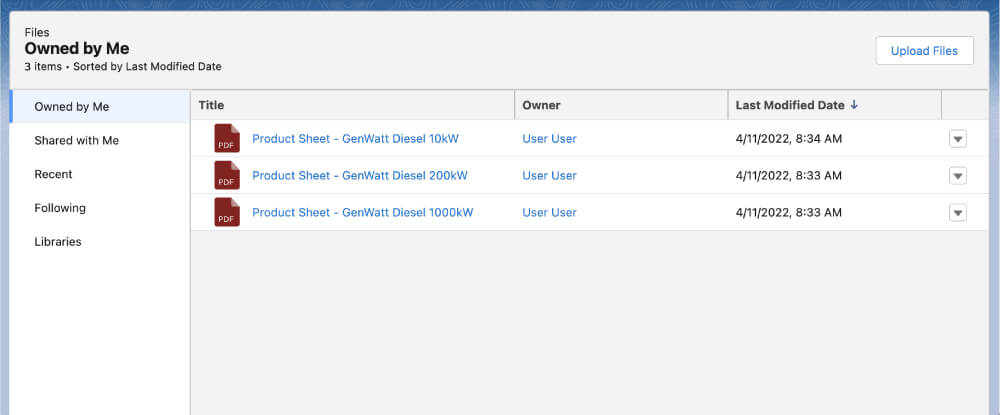

Whether you're sharing a Salesforce file with a colleague, adding a document to a Chatter post, running a usage report on a content library, or linking to external content with our own Drive Connect app, you're using Salesforce Files, Salesforce's system for adding, sharing, and managing files and documents.
Getting started with Files is as easy as uploading a single document to a record page, but fully understanding how it works can be a little trickier. Let's take a look at some frequently asked questions about Salesforce Files:
What are Salesforce Files?
Salesforce Files Basics
Again, Salesforce Files is a system for adding, sharing, and managing files within Salesforce. It supports all major file formats (including .docx, .pdf, .ppt, .pptx, .xls, and .xlsx) and image types (including .gif, .jpg, and .png). Each individual file has a maximum size of 2 GB, but the total amount of file storage in your org depends on your Salesforce edition and number of individual user licenses. It's available in Essentials, Group, Enterprise, Professional, Performance, Unlimited, Contact Manager, and Developer Editions.
Salesforce Attachments vs. Files
If you're a longtime Salesforce user, you're probably familiar with Attachments, Salesforce's previous tool for adding files to records. Salesforce Attachments are read-only documents that are associated with a specific record, and can only be viewed or downloaded. Salesforce Files are far more versatile, and are designed for sharing and collaboration. Attachments have largely been phased out in favor of Files, and while the legacy Notes & Attachments related list is still available in Lightning Experience, documents added to it will be uploaded as Files.

Where are Files Stored in Salesforce?
Well, that depends on what you're really asking. If you're a Salesforce user who wants a central list view of all the Files scattered across your organization, you're going to want to check out the Files tab. Here, you can view, search, filter and share all Files that are owned by or shared with you, including files that are stored in CRM Content libraries. If Files Connect is enabled for your organization, you can also use the Files tab to view files that are linked to Salesforce from external systems like Sharepoint and Google Drive.
If you're a developer who's interested in what's going on underneath the hood, the answer is a little more complicated. Salesforce Files are stored in the ContentDocument object, and the content of individual versions of those files are stored in its child ContentVersion object. For more on that, dig into Salesforce's SOAP API Developer Guide – and stay tuned for our complete guide to the Salesforce Files data model.

How to Add Salesforce Files
There are as many ways to upload a file as there are little nooks and crannies in your average Salesforce org. Salesforce's complete list of ways for a file to make its way to the Files tab is as follows:
- Attaching a file to an individual record via Notes & Attachments or Files related lists
- Attaching a file to a Chatter feed or comment
- Having a file shared with you via the Sharing Settings dialog box
- Uploading a file to a Salesforce CRM Content library
- Having a file uploaded to a CRM Content library you're a member of
- Having a content pack or web link uploaded to Salesforce CRM Content
Salesforce Files Privacy
There are three sharing settings for Salesforce Files: Private, Privately Shared, and Your Company.
- Private is the highest level of security for Salesforce Files. Generally, access to Private files is limited to the file owner and users with Modify All Data permissions. Files within private Libraries are even more tightly controlled – file owners are the only users with access.
- Privately Shared files are available to specific users: file owners, users with Modify All Data or View all Data permission, and users that have been granted access via private sharing or access to a private group or library.
- Your Company is the least restrictive level of security for Salesforce Files. Files that have been shared to public feeds, groups, profiles, or records will be made available for all users within your organization.
As the owner of a file, you can view its sharing settings and all users & groups that have been granted access on its File Detail page. Here, you can also manage the level of file access granted to each individual user and group. Files shared with individuals are granted Collaborator access – including the ability to edit file details and upload new versions – by default, while files shared with groups are granted Viewer access by default. Here's Salesforce's complete list of actions that can be performed on files by users at various levels of access:
| Action | Owner | Collaborator | Viewer |
|---|---|---|---|
| View or Preview |
✓ |
✓ |
✓ |
| Download |
✓ |
✓ |
✓ |
| Share |
✓ |
✓ |
✓ |
| Attach a File to a Post |
✓ |
✓ |
✓ |
| Upload New Version |
✓ |
✓ |
|
| Edit Details |
✓ |
✓ |
|
| Change Permissions |
✓ |
✓ |
|
| Make a File Private |
✓ |
||
| Restrict Access |
✓ |
||
| Delete |
✓ |
How to Delete Files in Salesforce
File owners and users with Modify All Data permissions can delete a file from its detail page, from its content detail page, or from a Chatter feed where it appears. This removes the file from your Salesforce org and ends access to all users that were previously granted access. If you've deleted a file, you can restore it and its associated sharing settings from the Recycle Bin.
What are the Limitations of Salesforce Files?
While Files supports all major file types and grants you a lot of flexibility with respect to sharing and collaboration, there are still some limitations to keep in mind. Here are the big ones:
- As mentioned above, individual file sizes are limited to 2 GB. Overall file limitations depend on the amount of storage in your org.
- Each individual file can be shared privately a maximum of 2000 times. At some point, it's time to just make it public.
- The maximum number of files and versions that can be published in a 24 hour period is 200,000, and it's limited even further to 2000 in Developer Edition and Sandboxes.
- As with many things in the Salesforce world, Files are a little wonky on mobile devices. Mobile uploads are limited to 100 MB per file instead of the usual 2 GB, and previewing and sharing functionality is limited.
We built Drive Connect on the Salesforce Files framework in order to make it a seamless part of the Salesforce ecosystem. Try it out for yourself with a 14-day free trial.
Try Drive Connect for Free
You can use the app for 14 days with no credit card required.
